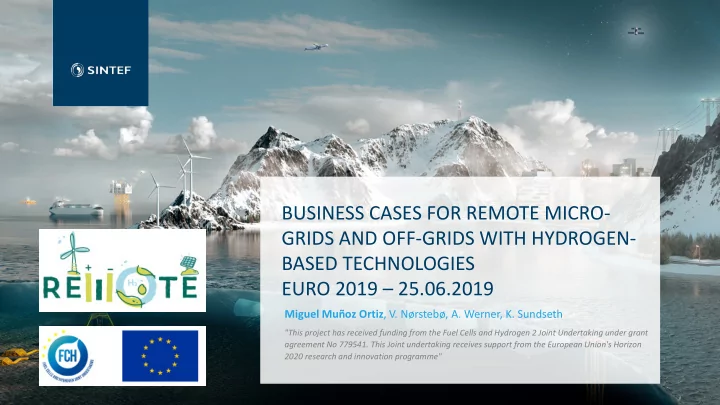

BUSINESS CASES FOR REMOTE MICRO- GRIDS AND OFF-GRIDS WITH HYDROGEN- BASED TECHNOLOGIES EURO 2019 – 25.06.2019 Miguel Muñoz Ortiz , V. Nørstebø, A. Werner, K. Sundseth "This project has received funding from the Fuel Cells and Hydrogen 2 Joint Undertaking under grant agreement No 779541. This Joint undertaking receives support from the European Union's Horizon 2020 research and innovation programme"
Agenda • Introduction • Methodology • Application in EU project REMOTE • Results • Conclusions • Future work Disclaimer: "Any contents herein reflect solely the authors’ view. The FCH 2 JU and the European Commission are not responsible for any use that may be made of the information herein contained." 2
Introduction • Sintef Industry • Department: Sustainable Energy Group: Operation Research and Economics • • We develop and provide actors in the private and public sectors with tools and methods to take rational and sustainable decisions. Source: Google maps Richard Birkelands vei 3 7034 Trondheim, Norway 3
Introduction • EU requires a Resilient Energy Solution • Increase of Renewable Generation ( PV and Wind ) • Intermittency demands bulk energy storage solutions • Batteries not viable in storing energy for more than one day • No network in isolated micro-grids and off-grid remote areas • Hydrogen-based P2P storage viable solution compared to diesel generators 4
Methodology • Model HyOpt (hydrogen-energy system optimisation model) • Programmed in Mosel language • Xpress solver • Optimisation model for a given case or load • MILP including strategic and operational decisions • Flexible time resolutions • Used in a number of industry and research projects. 5
Methodology • Nodes: building block • Production plants • Markets • Storage • Transport • Decision variables: strategic & operation variables • Technical constraints depending on node • Objective function: minimise NPV of the energy system 6
Methodology INPUTS: • Load profile during operation period (e.g. yearly profile with hourly resolution) • Technology costs: CAPEX, OPEX, regeneration costs • Renewable production profiles (wind, PV etc.) • Other techno-economical inputs (production functions, efficiency, discount rate). 7
Methodology OUTPUTS: • Investment decisions (technology capacity and its costs) • System operation (hourly and yearly energy production, flows) • Levelised cost of energy ( LCOE ) of the system • CO 2 emissions 8
Application in EU project REMOTE • "R emote area E nergy supply with M ultiple O ptions for integrated hydrogen-based TE chnologies" • Island operation of renewable energy systems • Duration: 4 years • Project start: January 2018 • Sintef's role: local coordination, data analysis, business models and LCA 9
Application in EU project REMOTE Four demos: • Demo 1 Ginostra (IT): diesel generators • Demo 2 Agkistro (GR): connection to grid • Demo 3 Ambornetti (IT): invasive grid connection or diesel generators • Demo 4 Froan (NO): Replacement of sea cable Illustration: Politecnico di Torino 10
Application in EU project REMOTE Storage (P2P and battery) RES system Renewable energy Generic RES solution: Water sources • Renewable sources: PV, Wind turbines, hydropower and Electrolyser Power biomass CHP generator. Electricity flow Balance Hydrogen flow • Li-ion battery H2 Battery • P2P hydrogen storage storage Loads Power load Fuel cell 11
Application in EU project REMOTE Different cases: • Base case with sizing from previous deliverables • HyOpt optimal solution with flexibility in chosing storage and renewable production capacity • Optimal solution with only battery as storage 12
Results Installed capacity Demo 4 Froan per case 1400 1200 Installed capacity (kW,kWh, kg) 1000 800 600 400 200 0 Wind turbines PV panels Electrolyser H2 storage (kg) Fuel cell (kW) Batteries (kWh) (kW) (kWp) (kW) Base case (min. 95% autonomy) HyOpt optimal (min. 95% autonomy) HyOpt optimal (min. 98% autonomy) Only battery (min 95% autonomy) 13 Only battery (min. 98% autonomy)
Results Power load demo 4 Froan HyOpt optimal (95% autonomy) 0,08 0,06 load [MW] 0,04 0,02 0 2904 2907 2910 2913 2916 2919 2922 2925 2928 2931 2934 2937 2940 2943 2946 2949 2952 2955 2958 2961 2964 2967 2970 2973 2976 operational time (h) PowerLoad Wind turbines PV panels Fuel cell Battery Storage levels demo 4 Froan HyOpt optimal (95% autonomy) 200 0,1 battery level [MWh] hydrogen level [kg] 150 0,08 0,06 100 0,04 50 0,02 0 0 2904 2907 2910 2913 2916 2919 2922 2925 2928 2931 2934 2937 2940 2943 2946 2949 2952 2955 2958 2961 2964 2967 2970 2973 2976 operational time (h) 14 Battery load [MW] Compressed H2 storage
Results NPC different cases Demo 4 Froan (k€) 4 500 4 000 3 500 3 000 2 500 2 000 1 500 1 000 500 0 Base case Optimal HyOpt case Only battery case Alternative 15 min. 95% autonomy min. 98% autonomy Sea cable (100% autonomy)
Results Load of demos versus LCOE 1,2 600 1 500 Demo load (MWh/year) 0,8 400 LCOE (€/kWh) 0,6 300 0,4 200 0,2 100 0 0 Demo 1 Ginostra Demo 2 Agkistro Demo 3 Ambornetti Demo 4 Froan (autonomy 98%) (autonomy 98%) Total load (MWh/year) LCOE current/alternative solution LCOE Base case LCOE optimal HyOpt case 16
Conclusions • Renewable solution with hydrogen and batteries appropriate solution • Hydrogen storage still expensive, but necessary in remote areas • Solutions with larger loads (350-600MWh/year) present lower LCOE • Fuel cell not used actively, but vital • Only battery solutions larger LCOE (if large autonomy is expected) • Alternative solutions larger LCOE • Increase income by selling hydrogen and by-products 17
Future work • Model used in other projects • Model documentation • Scientific publication on HyOpt with application on REMOTE • Life Cycle Analysis in REMOTE 18
Contact • Miguel Muñoz Ortiz Thank you for your attention! • e-mail: miguel.ortiz@sintef.no • Phone: +47 413 75 237 Questions? • Address: Richard Birkelands vei 3, 7034 Trondheim, Norway 19
Teknologi for et bedre samfunn
Recommend
More recommend